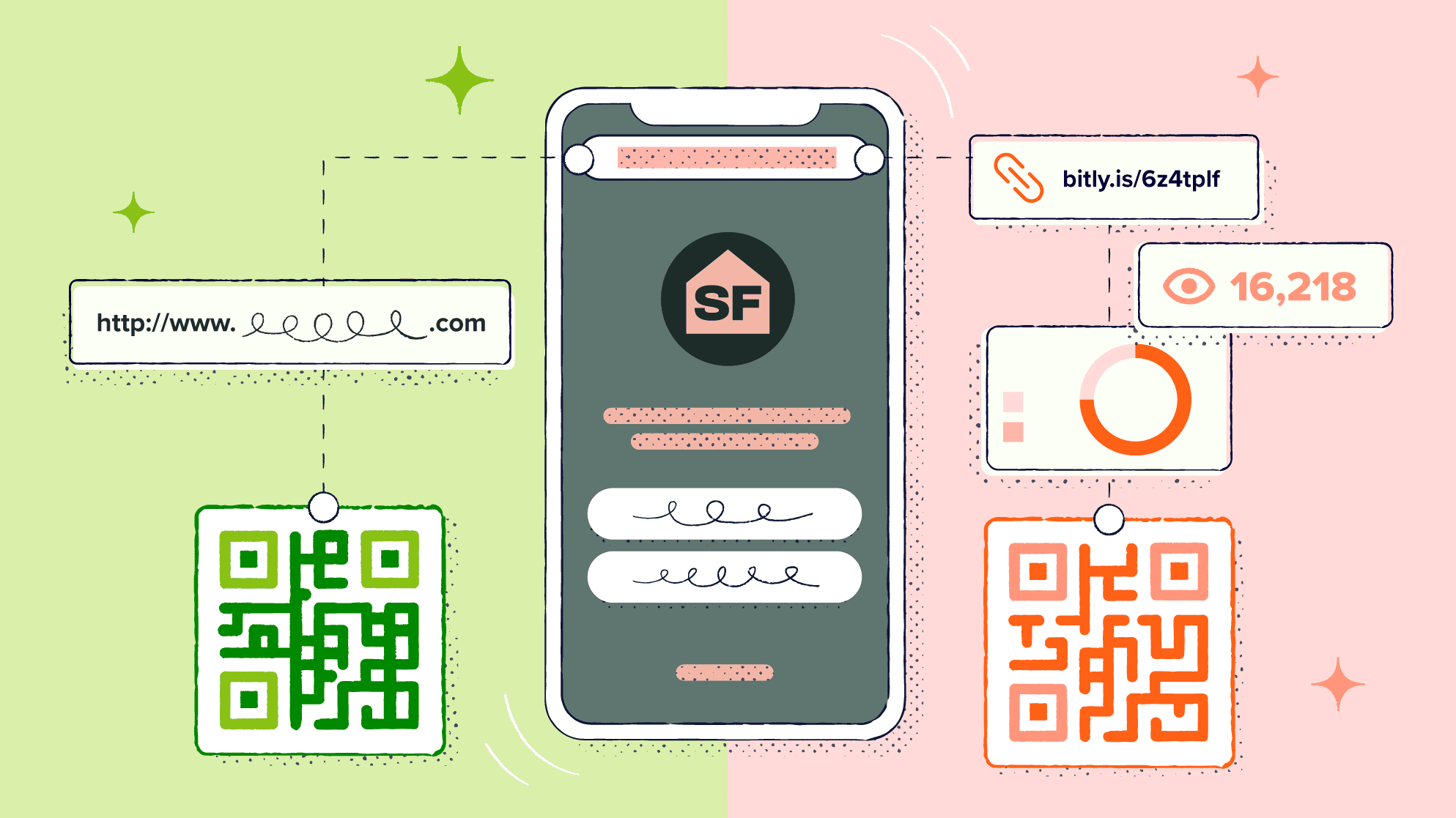
A Static QR (Quick Response) Code cannot be changed, edited, tracked, or used for retargeting. A Dynamic QR Code can do all those things and is easier to scan. Both types of QR Codes have had a resurgence since the pandemic as brands try to connect offline and online experiences.
Do Static and Dynamic QR Codes look different?
Static QR Codes often have a denser pattern of squares because their destination link is usually long. You might not notice the difference unless you see Static and Dynamic QR Code side by side. The sparser Dynamic QR Codes are typically easier to scan and remain scannable even when shrunk, unlike most Static QR Codes.
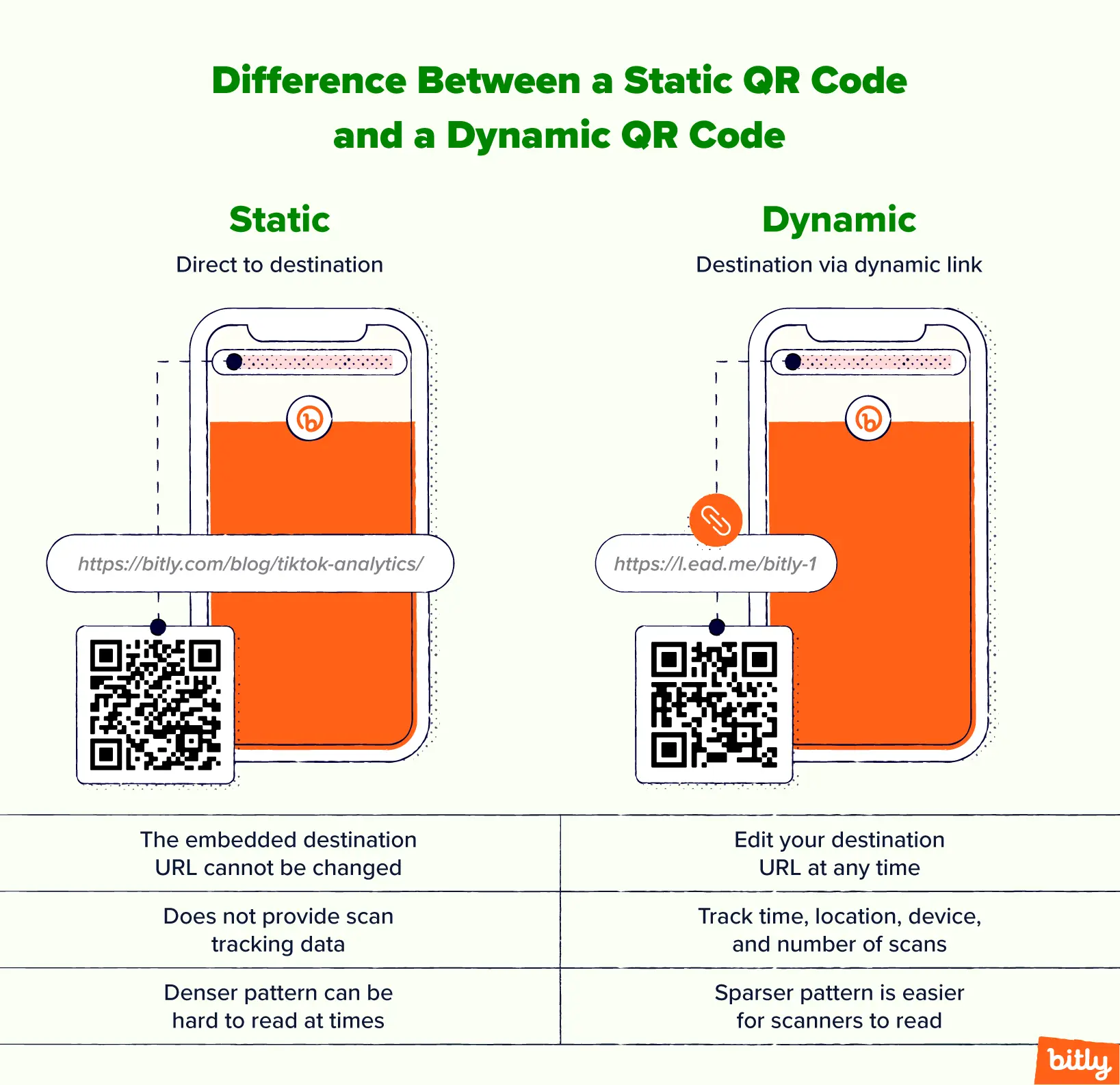
The image above shows that both types of QR Codes have prominent squares in three corners. Scanning devices (like smartphones) use these squares to orient the Code. The remaining pattern on the Static and Dynamic QR Codes looks different. As you see more QR Codes, you may start noticing the larger white areas and identify them as Dynamic QR Codes.
What is a Static QR Code?
A Static QR Code is a printable pattern that smartphone users can scan on signs, brochures, and other items. The scan calls up a destination URL, like an information or signup page. You cannot change a Static QR Code’s URL after its creation. However, you can change a Dynamic QR Code’s URL.
What is a Dynamic QR Code?
A Dynamic QR Code, also called an editable QR Code, looks similar to the older Static QR Code. However, it has more features, making it a valuable marketing tool. Dynamic QR Codes use short URLs to lead to an intermediary page, which marketers can direct to new URLs as necessary. You can also track QR Code scans and use that data to optimize multiple campaigns.
Some QR Code services offer free trials for Dynamic QR Codes, but there are usually limits to their usage. In a free trial, you might find that you can only change the destination URL a certain number of times or that your Dynamic QR Code may expire if you don’t upgrade. However, Dynamic QR Codes aren’t expensive. Rates go up based on the number of QR Codes and scans that you need, but remain inexpensive when compared with QR Code reprinting costs if you use Static Codes.
A Dynamic QR Code generator allows far more long-term flexibility and can save on the expense of reprinting QR Codes on signs and other items. Some QR Code generators like Bitly allow brands to generate Dynamic QR Codes at scale with a QR Code API. This can result in significant efficiency gains, optimization, and cost savings for large-scale marketing.
The Bitly QR Code Index reports that QR Code creations grew by 152% in the first half of 2022 vs. the same period in 2021. According to marketing futurist Anat Baron, QR Codes are more relevant today than ever, given how retail and marketing continue to change since the pandemic.
“While QR Codes aren’t new, they are one of the consumer success stories coming out of the pandemic,” says Baron. “Unlike Zoom and other tech offerings that thrived because they connected employees working remotely, QR Codes are still relevant post-pandemic. And I expect they will continue to grow as an important tool connecting the physical and digital worlds.”

Anat Baron, brand builder, futurist, and marketing keynote speaker.
7 benefits of Dynamic QR Codes over Static QR Codes
Anything you can do with a Static QR Code, you can do with a Dynamic QR Code. Other benefits of Dynamic QR Codes are that you can change the URL without reprinting it, scan them faster, track the scans, and use short URLs. You can easily integrate Dynamic QR Codes with other marketing platforms and retarget ads on various platforms like Google and Facebook.
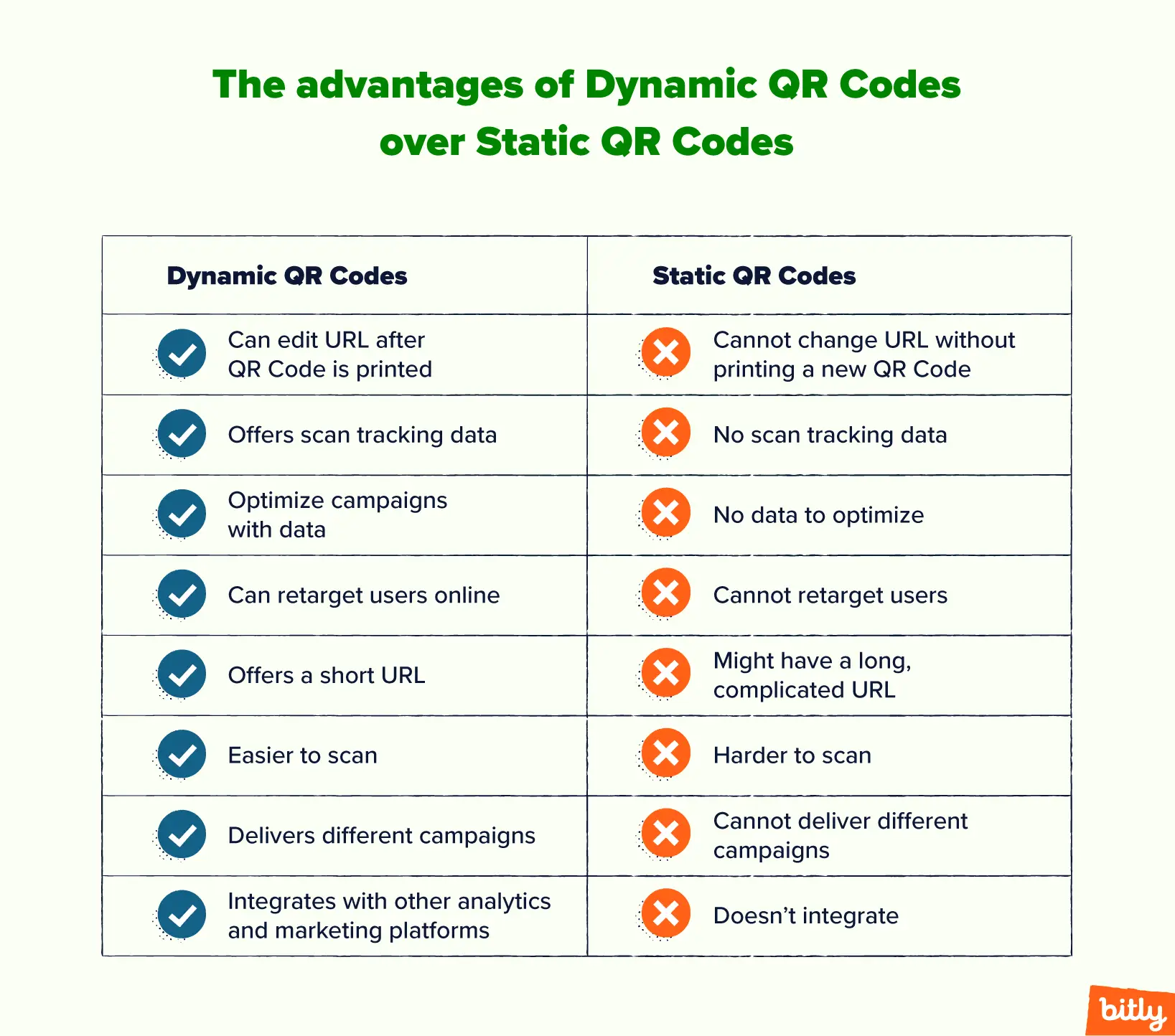
Here’s a more detailed look at the seven benefits of Dynamic QR Codes over Static QR Codes:
- Change the URL, not the QR Code
Don’t underestimate the advantage and potential cost savings here. Dynamic QR Codes eliminate the need to print new QR Codes on products or sales and marketing materials when changing the destination URL. Instead, you can simply edit the destination URL in the QR Code generator you used to create it. The change is effective immediately. - Track the scan data
Without the ability to track data, you don’t know the impact of your QR Code. Static QR Codes don’t support tracking. Marketers can use the scan data to optimize campaigns to match customer behavior, making them far more effective. - Scan the Codes faster
The sparser pattern of Dynamic QR Codes makes them easier and faster to scan. With Static QR Codes, you might not get the full effect of a frictionless experience. The user might have to hover their phone over the QR Code longer, change their angle, or wipe the window or table where the QR Code is affixed. The sparser design of Dynamic QR Codes is more forgiving, allowing phones to recognize the pattern faster. - Use a short URL and images
Dynamic QR Codes embed a shortened URL in the image. Users who scan a Dynamic QR Code will see the more attractive short URL. When users interact with it, it redirects them to the destination URL. - Customize the Dynamic QR Code
Many Dynamic QR Code generators provide a way to change the Code’s colors, patterns, and style. You can embed images like your logo in the QR pattern, making for a custom look. Static QR Codes don’t offer these design enhancements. - Integrate with other platforms
Dynamic QR Code platforms typically offer integration with other platforms, such as Google Analytics, Google Tag Manager, email service providers, and more. - Retarget ads
Using Dynamic QR Codes in your ads allows you to extend your impact beyond the original URL. Now you can nurture people who scanned your QR Code and serve them retargeted ads on various platforms like Google and Facebook.
Examples of when to use a Static or Dynamic QR Code
Still not sure which type of QR Code to use? This chart of use cases and which QR Code works best makes it easy to decide. While you can make a case for using a Static or Dynamic QR Code in many of these scenarios, we’re pointing out when a Static QR Code could be sufficient.
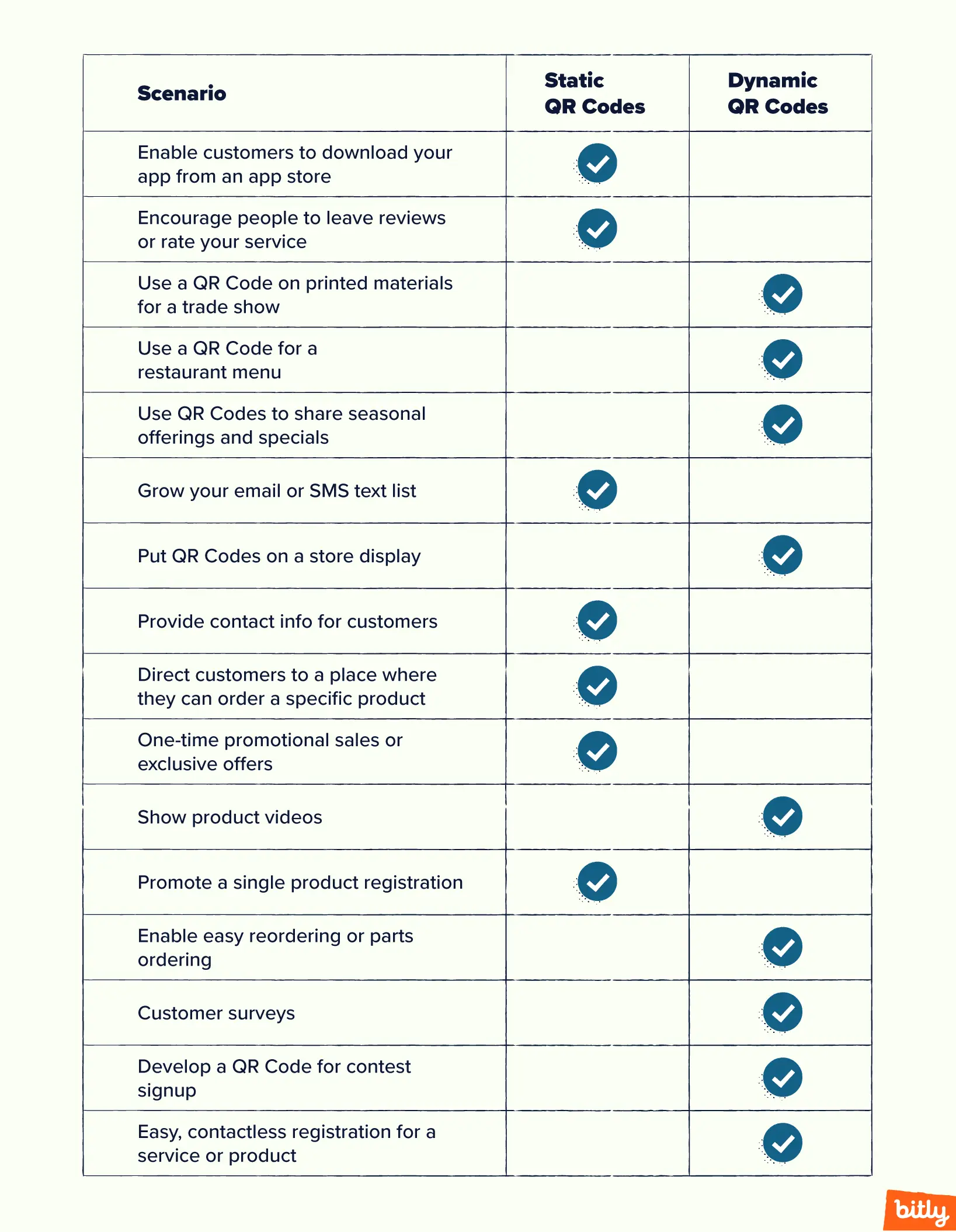
Every day, marketers and businesses are finding new ways to use Static and Dynamic Codes and people are more likely to interact with them than ever before. Futurist Baron explains, “While QR Codes were a hard sell 10 years ago, the ubiquity of the smartphone and the prevalence of QR Codes in the past few years have meant that there is no longer an education component for the consumer. Everyone learned how to use them while eating out in 2020 and 2021. And now that basic usage allows for more marketing opportunities.”
9 most common use cases for Static QR Codes
Small businesses and individuals use Static QR Codes to enable anyone to reach a web page without typing a web address. For example, people point their smartphone camera or scanning app at a QR Code to call up a website, video, or signup form. However, the URL it points people to can never change and you can’t track the scans.
Baron believes QR Codes have found their footing in the past few years as more people see the possibilities. “With the proliferation of information and data and the continuous battle for consumer attention, QR Codes provide an easy way to direct them to the right place with minimal effort,” Baron explains. “In some ways, it also shows that the brand or company is relevant because they’re eliminating friction, like typing in a URL, for the consumer.’’
Here’s a more detailed look at the most common use cases for Static QR Codes:
- Sharing basic personal or business information
Individuals can use Static QR Codes as an easy, free way to direct people to their website or contact information. Brands can direct customers to an unchanging URL, such as a website homepage, contact page, or Google map of their location. For example, a spa, pet grooming shop, or hair salon might print a free Static Code on its business cards or appointment cards that point to its website, since that URL is unlikely to change. Similarly, they can use a Static QR Code on printed materials to link to a virtual business card, replacing old-school printed business cards completely. - Customer communications
Brands can make it frictionless for customers to email or text them. The QR Code prefills the brand’s info in an email or SMS text. The customer simply scans the QR Code and is led to a prefilled email or text. The customer can add a short note, if necessary, and tap send. - Logging onto WiFi
A coffee shop, car dealer, or other business can display a Static QR Code that allows a customer to log onto the company WiFi for free internet service when scanned. - Scheduling a sales call
Salespeople can use the QR Codes to make it convenient for clients or potential clients to schedule a call, product demo, or business needs assessment. The business can print a QR Code on a brochure or business card that calls up a schedule form with available time slots. The customer scans the QR Code, views the calendar, chooses a time slot, and taps send. - Promoting a social media following
Print a Static QR Code on sales materials, on a store window, or at a restaurant table to promote your brand’s social media accounts. The QR Code could lead to web pages linking to all social accounts, or each QR Code could link to the brand’s respective social pages on Facebook, Instagram, Yelp, LinkedIn, or other outlets. - Long-term promotions
You can use Static QR Codes for marketing campaigns that won’t need to adjust the destination URL, such as long-term promotions. Examples include a recurring weekly restaurant promotion or pointing users to a price-match guarantee page. - Calling up an informational page, video, or MP3 audio clip at a venue
Museums, zoos, nature parks, and other places can place signs with QR Codes that lead users to pages or videos about what they’re seeing. For example, a museum might show the artist’s bio or share audio that describes a sculpture. A zoo might share details about an animal’s habits. A park may provide information about a tree, landscape feature, or wildlife. - Free experimentation
Anyone who is starting with QR Codes and wants to try a simple proof of concept should start with a Static QR Code. Providers of Static QR Codes typically allow continuing free use, but keep in mind you can’t change the URL or get tracking data. - Promoting downloads of your app
Brands can print a QR Code that conveniently leads smartphone users to the app download page.
Read our article on QR Code use cases for more ideas.
18 most common use cases for Dynamic QR Codes
Dynamic QR Codes enable all the benefits of Static QR Codes but with much more flexibility and tracking capabilities. For example, you can change the destination URL of Dynamic QR Codes, so you never have to replace printed QR Codes.
Here is a list of the most common use cases for Dynamic QR Codes:
- Running and optimizing multiple QR Code campaigns
Marketers use Dynamic QR Code platforms to organize multiple QR marketing campaigns. On these platforms, you can conduct a series of campaigns from the same URL without reprinting the Codes. These platforms also provide scan data, such as seeing which scan locations or times perform best. Marketers use that data to prioritize their efforts, such as where or when to distribute printed sales materials. They can also use the QR scan data to compare the channel’s performance with email, SMS, organic search, paid ads, and other channels. Without this data, you wouldn’t know how a QR campaign is doing, or what it’s contributing toward your multi-channel efforts. - Wanting to avoid so many QR reprints
Some people start with Static QR Codes but then outgrow them. You might discard printed materials because you need to reprint the Static QR Code. Once you switch, you can use your new Dynamic QR Code to lead to promotional campaigns, different contest sign-ups, new product sales pages, and even different contact details in vCards. - Enabling integration with other tools
Dynamic QR Code platforms allow you to integrate with Google Analytics, email providers, Zapier, and other useful platforms for easy data flow. Static Codes don’t provide integrations with your other analytics and marketing tools. - Updating restaurant menus online
Many customers became more accustomed to QR Codes during the pandemic as restaurants used them as a contactless method for diners to order meals. Some restaurants started with Static QR Codes but then learned the advantage of Dynamic QR Codes to offer updates and track customer data. - Printing QR Codes on product packaging or inserts
Brands often invest heavily in product packaging that includes QR Codes. They want the ability to update the destination URLs and track the scan data, so Dynamic QR Codes are a must. The Dynamic QR Codes might call up instructional videos, accessory or parts ordering pages, product registration forms, warranty request forms, or other information. - Running contests and giveaways
Companies print QR Codes on fliers, signs, or products to promote contests, loyalty programs, and giveaways. Customers scan the QR Code on a beverage packaging to call up a contest form or promote buzz around a new product. With Dynamic QR Codes, the brand can rotate these campaigns and track them. - Surveying your customers
A QR Code on a receipt, invoice, or product package can call up a survey for customers to fill out. This allows a convenient way to communicate with people right as they get your product or service. In addition, you can use it to promote special offers, such as product accessories. - Retargeting customers on other platforms
With Dynamic QR Codes, you can place a retargeting pixel, allowing you to remarket to people who have used the QR Code. Now you have extended your reach with that customer beyond the original URL they landed on. - Calling up a 3D display, augmented reality app, or virtual visit
A venue such as an art gallery or history museum can use Dynamic QR Codes at exhibits to call up a 3D version or augmented reality experience on top of the real-world artwork or historical artifact. For example, a dinosaur skeleton could come alive with a QR Code scan. A brochure can use a QR Code to link to a virtual visit to the museum. - Printing QR Codes directly on apparel and accessories
Clothing brands can put Dynamic QR Codes on items to enable customers to call up product info, style suggestions, online shopping pages, care instructions, or special offers. - Putting QR Codes in window displays or on store shelves
Even when your store is closed, customers can view your display and scan the QR Code to get product details or online order forms. Businesses can use these Dynamic QR Codes to allow shoppers to call up product ratings, demonstration videos, or other information. - Printing QR Codes on publications and improving pickup rates
Magazine and newspaper publishers use Dynamic QR Codes to lead readers to subscription signups, online supplementary material, videos, or advertiser pages. The tracking data shows them which locations do best as distribution points and they can adjust accordingly. - Growing an email or SMS contact list
Brands use QR Codes to make it easy for customers to sign up for an email list or SMS alerts, such as for sales, exclusive offers, product updates, or newsletters. - Registering or getting information at a facility
QR Codes are used at hospitals, government offices, or other facilities for people to call up information, sign in online, or wear badges carrying a QR Code. - Replace any current use of Static QR Codes
It’s important to note that anything you can do with a Static QR Code, you can do with a Dynamic QR Code. And you can do it with more flexibility and tracking. So yes, you can use Dynamic QR Codes to prefill an email or SMS text, reserve a time slot on a calendar, go to any website page, or do anything else you can do with a Static QR Code. - Create product buzz
For example, Marvel has used QR Codes to create interest in its Moon Knight series by sending users to exclusive online comics that change weekly.
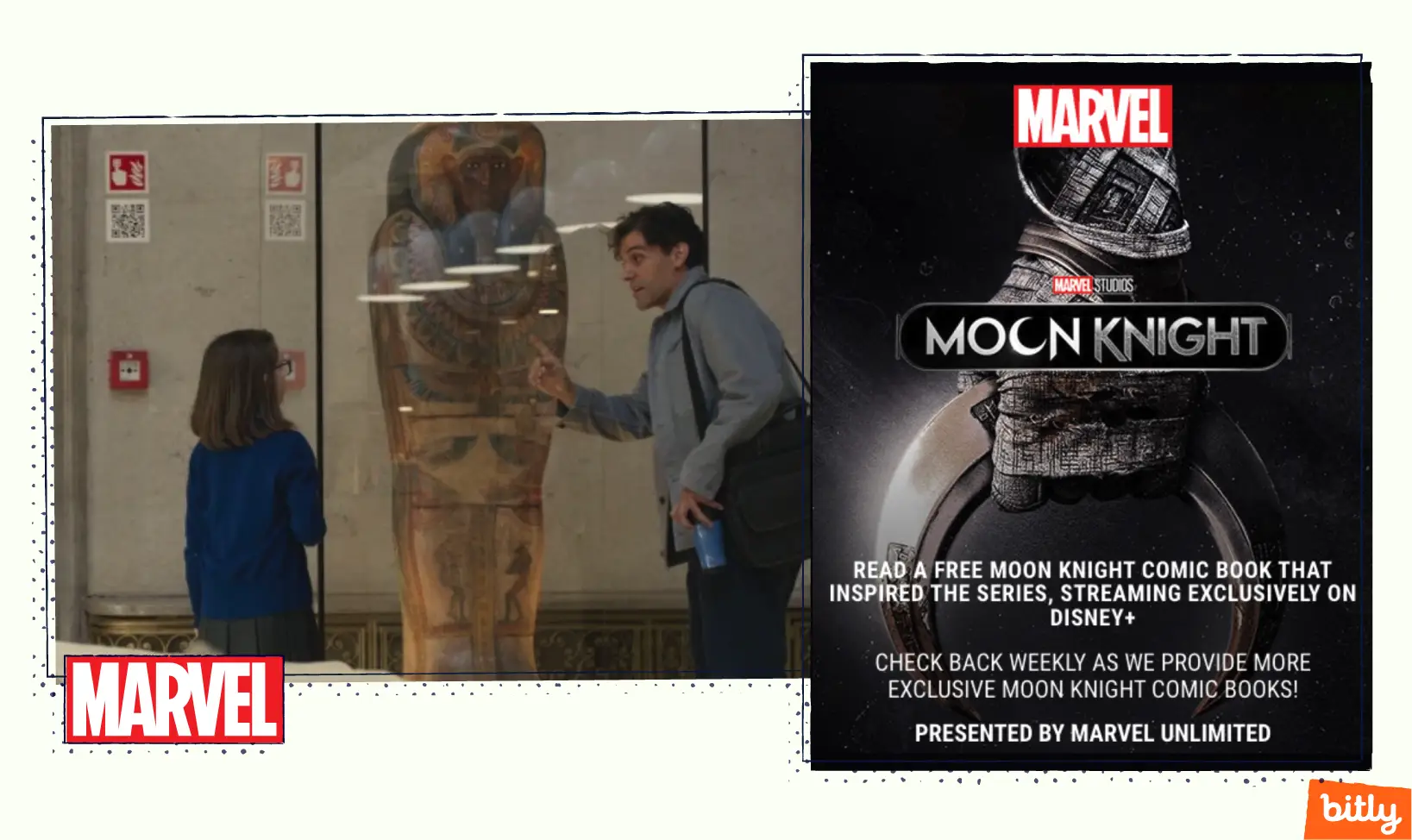
Why you should use Bitly for Static and Dynamic QR Codes
A Dynamic QR Code generator, like Bitly’s QR Code generator, allows far more long-term flexibility and can save on the expense of reprinting QR Codes on signs and other materials. That’s not the case with Static QR Codes. Bitly also allows brands to generate Dynamic QR Codes at scale with our QR Code API. This can result in significant efficiency gains, optimization, and cost savings for large-scale marketing.
Companies need an easy, efficient way to generate and use QR Codes in their marketing channel mix. With the Bitly Connections Platform, you can create, customize, and manage your Dynamic QR Codes.
Want even more flexibility? Try Bitly’s newest product, QR Code Generator, for Dynamic QR Codes on products, packaging, displays, and printed materials. You can create QR Codes that include audio, social media sites, videos, images, and PDFs. You can customize the color, shape, frame, logos, and fonts on your QR Codes. Finally, you can thoroughly analyze Dynamic QR Code campaigns, including total scans, operating systems, and location data.
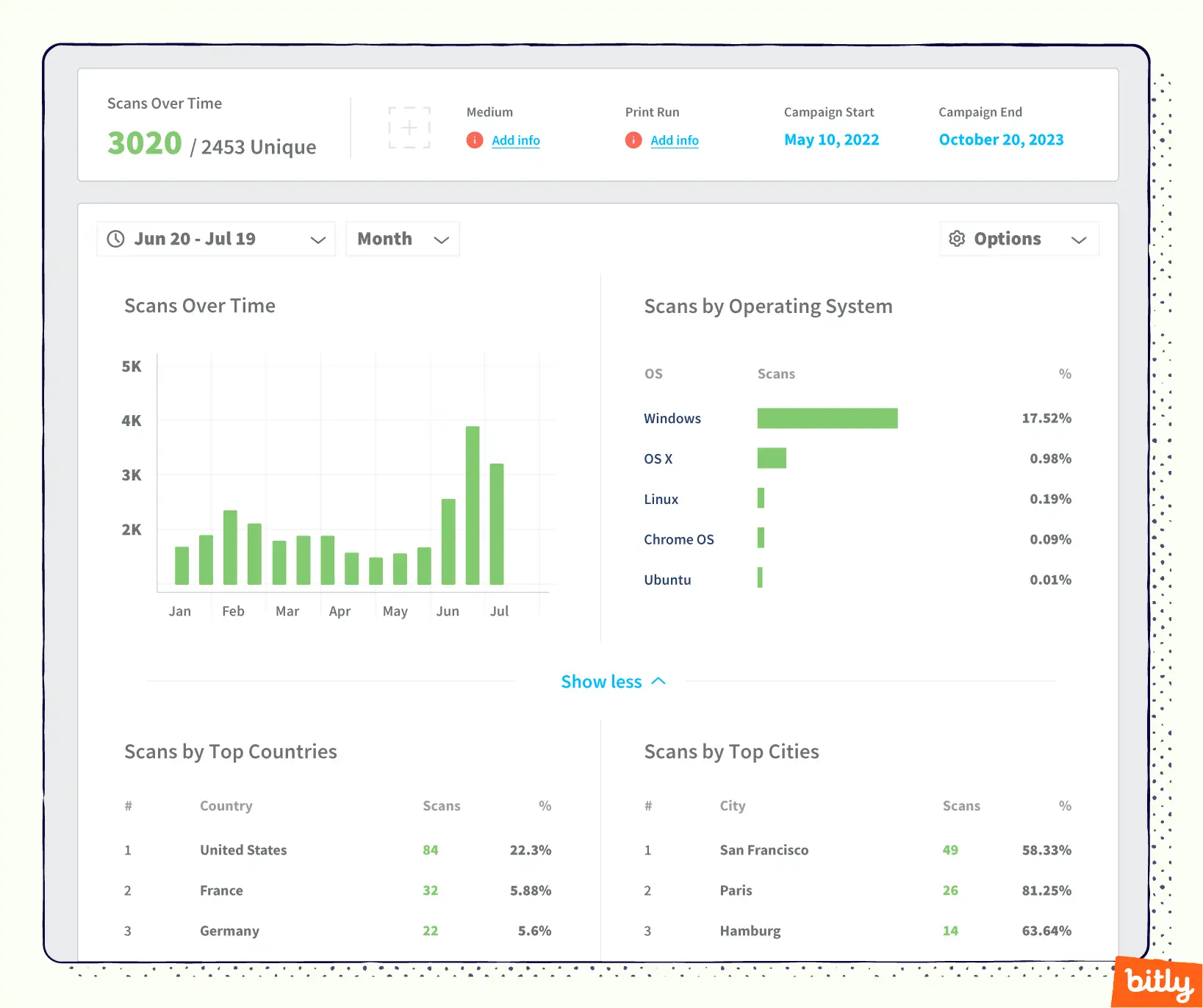
Static and Dynamic QR Code FAQs
Here are frequently asked questions about Static QR Codes and Dynamic QR Codes.
- Can you change a Static QR Code to a Dynamic QR Code?
No, you can’t. Once you create and print a Static QR Code, you can’t adjust its embedded URL or enable Dynamic tracking. You would have to create and print a new QR Code to point to something new. On the other hand, Dynamic QR Codes have editable URLs and automatic tracking. - Why do Dynamic QR Codes cost more?
Dynamic QR Codes require more advanced technology for editable URLs and analytics. You can get a free Dynamic QR Code trial, but it may not stay live long-term and you may be limited on the times you change the destination URL. However, Dynamic QR Code subscription plans aren’t expensive. - Which is better: Static or Dynamic QR Codes?
Overall, Dynamic QR Codes are better. They can do anything a Static QR Code can do, plus more. They allow editable URLs and more analytics. However, a Static QR Code may work for you if you only want a single embedded URL and no analytics.